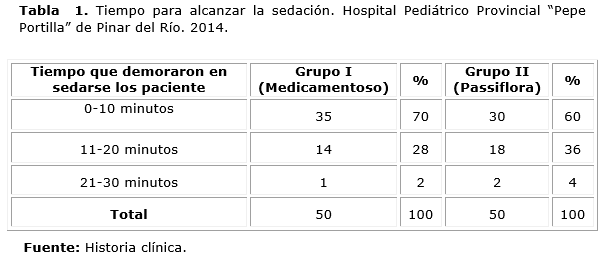Sedation with medication and homeopathy for electroencephalographic study in children
Keywords:
Neurological examination/methods, Chloral hydrate, Passiflora.Abstract
Introduction: neurological disorders are one of the most common diseases in pediatric ages. To study these disorders, the recording of brain electrical activity through electroencephalogram is very useful. Sedation is necessary in young children to obtain a record of sleep, usually performed, despite its drawbacks with drug treatment.Objective: to assess the sedative effect of homeopathic passionflower at 6CH to conduct EEG in children compared with chloral hydrate and diphenhydramine syrup.
Material and method: an experimental study was conducted with 100 children of both sexes between one and four years old attending the Provincial Department of Neurophysiology at "Pepe Portilla" Pediatric Hospital, Pinar del Rio 2014, to undergo EEG under sedation. A randomized systematic sampling was performed to assign and form two groups of treatment (conventional and homeopathic) with 50 patients each, which was compared by the effectiveness of sedation and its duration.
Results: sedation with the 6CH passionflower was as effective as than the one obtained with conventional treatment using chloral hydrate and diphenhydramine syrup, achieving and maintaining all children sedated without the occurrence of adverse reactions, throughout the electroencephalogram.
Conclusions: passionflower is an effective and safe homeopathic medication to sedate young children; it is a therapeutic alternative to perform EEG to diagnose central nervous system diseases.
Downloads
References
1. Ramírez Campos J, Núñez Velásquez M, Cárdenas Rojo N, Sevilla-Castillo RA, Palacios Saucedo GC. Confiabilidad intra e interobservador de la lectura del EEG en pacientes pediátricos con alteraciones Neurológicas. Rev Med Inst Mex Seguro Soc[Internet]. 2014[citado 09 feb 2015]; 52(4): [aprox. 6 p.]. Disponible en: http://www.medigraphic.com/pdfs/imss/im-2014 /im144h.pdf
2. Mahmoud Reza A, Reza Azizi M, Gholam Reza Z, Mahmoud M, Firozeh H. Sleep Inducing for EEG Recording in Children: A Comparison between Oral Midazolam and Chloral Hydrate. Iran J Child Neurol[Internet]. 2013[citado 09 feb 2015]; 7(1): [aprox. 5 p.]. Disponible en: http://www.ncbi.nlm.nih.gov/pmc/articles/PMC3943082/
3. Gumus H, Bayram AK, Poyrazoglu HG, Canpolat DG, Per H et al. Comparison of Effects of Different Dexmedetomidine and Chloral Hydrate Doses Used in Sedation on Electroencephalography in Pediatric Patients. J Child Neurol[Internet]. 2014 sep-22 [citado 09 feb 2015]; 17(9): [aprox. 8 p.]. Disponible en: http://jcn.sagepub.com/content/early/2014/09/17/0883073814549582.long
4. Dutto S, Uema S. Vigencia en el uso del hidrato de cloral en pacientes pediátricos para procedimientos de diagnóstico. Rev UNC [Internet]. 2013[citado 09 feb 2015]; 1(2): [aprox. 9 p.]. Disponible en: http://revistas.unc.edu.ar/index.php/Bitacora/article/view/5571/6029
5. Bustos Fierro C, Olivera ME, Manzo FG, Jiménez Kairuz AF. Evaluación de la estabilidad de un jarabe de hidrato de cloral al 7% en envases mono y multidosis bajo condiciones ambiente y de refrigeración. Farm Hosp[Internet]. 2013 ene-feb [citado 09 feb 2015]; 37(1): [aprox. 9 p.]. Disponible en: http://scielo.isciii.es/scielo.php?pid=S1130-63432013000100002&script=sci_arttext
6. García Mesa AIC. Resultado del tratamiento homeopático en la calidad de vida del paciente pediátrico con dermatitis atópica. Rev Fac Med[Internet]. 2013 jul-dec[citado 09 feb 2015]; 21(2): [aprox. 9 p.]. Disponible en: http://www.scielo.org.co/scielo.php?Pid=S0121-52562013000200009&script=sci_arttext
7. Danno K, Colas A, Masson JL, Bordet MF. Homeopathic Treatment of Migraine in Children: Results of a Prospective, Multicenter, Observational Study. The Journal of alternative and Complementary Medicine[Internet]. 2013[citado 09 feb 2015]; 19(2): [aprox. 5 p.]. Disponible en: http://online.liebertpub.com/doi/full/10.1089/acm.2011.0821
8. Marseglia L, D'Angelo G, Manti S, Aversa S, Arrigo T, Reiter RJ, et al. Analgesic, anxiolytic and anaesthetic effects of melatonin: new potential uses in pediatrics. Int J Mol Sci[Internet]. 2015 jan[citado 09 feb 2015]; 16(1): [aprox. 11 p.]. Disponible en: http://www.ncbi.nlm.nih.gov/pmc/articles/PMC4307299/
9. Davidson, PN. Sedation alternatives. Neurodiagn J[Internet]. 2014 Jun[citado 09 feb 2015]; 54(2):110-24. Disponible en: http://www.ncbi.nlm.nih.gov/pubmed/25080771
10. Fallah R, Jalili S, Golestan M, Karbasi SA, Jarahzadeh MH. Efficacy of Chloral Hydrate and Promethazine for Sedation during Electroencephalography in Children; a Randomised Clinical Trial. Iran J Pediatr[Internet]. 2013 feb[citado 09 Feb 2015]; 23(1): [aprox. 5 p.]. Disponible en: http://www.ncbi.nlm.nih.gov/pmc/articles/PMC3574988/

Published
How to Cite
Issue
Section
License
Authors who have publications with this journal agree to the following terms: Authors will retain their copyrights and grant the journal the right of first publication of their work, which will be publication of their work, which will be simultaneously subject to the Creative Commons Attribution License (CC-BY-NC 4.0) that allows third parties to share the work as long as its author and first publication in this journal are indicated.
Authors may adopt other non-exclusive license agreements for distribution of the published version of the work (e.g.: deposit it in an institutional telematic archive or publish it in a volume). Likewise, and according to the recommendations of the Medical Sciences Editorial (ECIMED), authors must declare in each article their contribution according to the CRediT taxonomy (contributor roles). This taxonomy includes 14 roles, which can be used to represent the tasks typically performed by contributors in scientific academic production. It should be consulted in monograph) whenever initial publication in this journal is indicated. Authors are allowed and encouraged to disseminate their work through the Internet (e.g., in institutional telematic archives or on their web page) before and during the submission process, which may produce interesting exchanges and increase citations of the published work. (See The effect of open access). https://casrai.org/credit/


